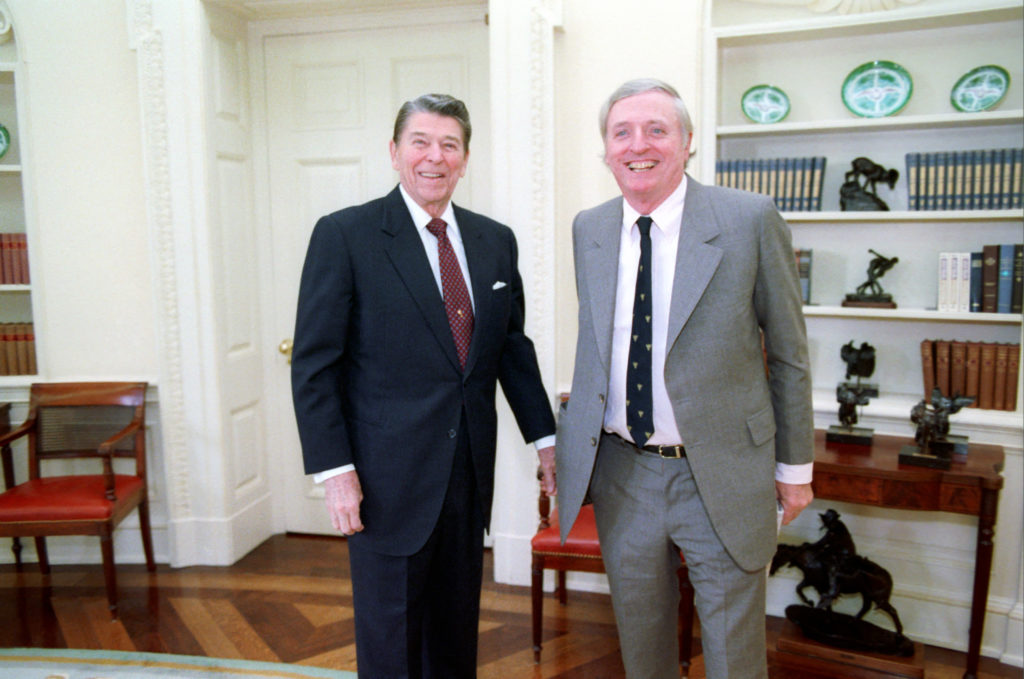The two faces of the New Right

Rick Perlstein and Edward H. Miller explain why the current frame that assumes there’s some sort of struggle going on now for the soul of the Republican party between the crazies and the old-fashioned Reasonable Right is deeply misguided:
It was the John Birch Society that first discovered the power of the nascent Christian right’s most galvanizing issue. And because the John Birch Society was a secular organization with members of all faiths, it pioneered the sort of operational unity between evangelical Protestants and Catholics that the Moral Majority received credit for when it came along, nine years after the Supreme Court’s landmark abortion rights decision in Roe—a group that Ronald Reagan hugged tight as an ally, even as Birchers were officially personae non gratae.
The John Birch Society leaders’ motivations for joining this fight, as always, were fantastical. They believed abortion was part and parcel of the strategy of the “Insiders”—the shadowy globalists who directedthe Communist conspiracy—to weaken America by shrinking its population. It was “people control,” just like “gun control.” That is how front groups work: Find an inviting come-on with the power to arouse an angry citizenry, even if it is just to win their vote; and if this becomes the gateway drug to sell the whole crazy conspiratorial package, all the better.
Another example: the ubiquitous Birch-issued bumper stickers to “SUPPORT YOUR LOCAL POLICE.” If you sported one to signify your horror at leftists who, then as now, criticized urban police forces as racist armies of occupation, fine. Maybe it will serve, to employ a contemporary anachronism, as your red pill, leading you to the twilight struggle against Insiders’ infernal conspiracy to make American police forces bought-and-paid-for adjuncts of the United Nations. QAnon functions much the same way when it sets up tables in town squares around the country urging none-the-wiser citizens to fight the scourge of global sex trafficking.
Other examples proliferate. Those in the know fought the Equal Rights Amendment, historian Erin Kempker demonstrates in her book Big Sister: Feminism, Conservatism, and Conspiracy in the Heartland, because they believed it a cat’s paw for one-world government. Meanwhile, the movement’s brilliant public-facing spokeswoman, Phyllis Schlafly, went on The Phil Donahue Show to explain the alleged harms ERA would do to women’s access to their husbands’ financial support—and “respectable” Republican politicians echoed that line.
At least since the mid-1950s, when William F. Buckley started running game out of New Haven, the strategy has been basically the same: present a fairly soothing Popular Front face to broader public, and especially to center-right to center-left pundits, who are contractually obligated to Both Sides literally everything, while at the same time fomenting endless forms of conspiratorial insanity among the base:
This habit of speaking to two audiences at once was mirrored at the level of Republican presidential politics. Ronald Reagan appeared beside Falwell at a rally of preachers at the height of his 1980 presidential campaign to proclaim, “I know that you can’t endorse me … I want you to know that I endorse you and what you’re doing.” Reagan’s endorsement occurred even as, backstage, a leading Christian Reconstructionist—an extremist movement that sought to make the Old Testament the foundation of American criminal law and considered the public school system a conspiracy to spread paganism as the national religion—complained that their guru, Dr. R.J. Rushdoony, had not been included in the event’s program. A Reagan campaign official reassured him: “If it weren’t for his books, none of us would be here.”
Such was the complex dance that has always been at the heart of Republican politics in the conservative era. The extremist vanguard shops fantastical horror stories about liberal elites in the hopes that one might break into the mainstream, such as the “Clinton Chronicles” VHS tape distributed by Jerry Falwell in the early 1990s. The stories included the Clintons covering up the murder of Vince Foster, murdering witnesses to their drug smuggling operation, and participating in a crooked land deal at a development called “Whitewater.” (The New York Times bit hard on the latter claim, setting in motion a chain of events that led to President Clinton’s impeachment over lying in a deposition about a sexual affair.)
The notion that there’s something new about Donald Trump, Marjorie Taylor Greene et. al. is dead wrong: the only thing that’s changed is that now the mask is increasingly torn off the leering face of the American right wing, to the point where many formerly go along to get along Democrats, most notably including Joe Biden, seem increasingly dedicated to the proposition that we won’t get fooled again.


